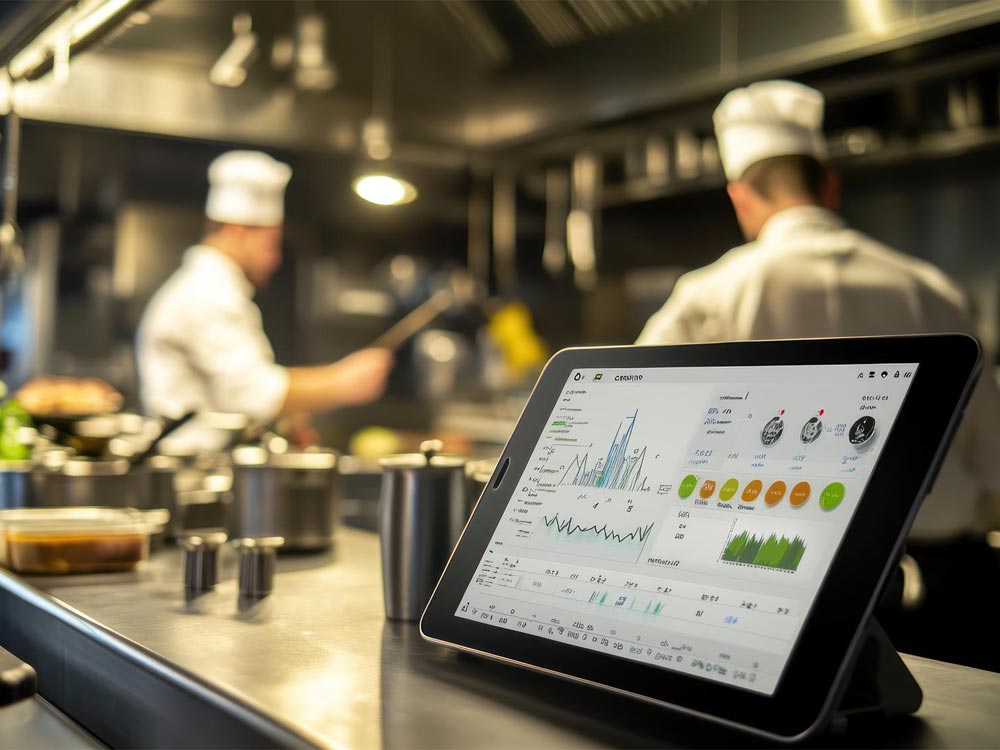In today’s dynamic restaurant landscape, efficient inventory management is no longer a luxury but a necessity, in fact it has a crucial role to play in profitability and success of a restaurant. Conventional methods of tracking and monitoring inventory are usually prone to errors, time consuming and do not offer enough insights for optimizing operations. This is where data analytics and reporting in inventory management software comes to the rescue.
With the help of data, restaurant owners and managers can have access to valuable insights related to their inventory, areas for improvement, and can execute data-driven decisions that focus on improving efficiency, reducing costs and eventually boosting their bottom line.
The comprehensive guide below will dive deep into the intricacies of data analytics and reporting in inventory management software. Let’s explore essential features, key benefits and best practices that this lot has to offer.

Key contents:
- The Importance of Data Analytics in Restaurant Inventory Management
- Essential Features of Inventory Management Software with Data Analytics and Reporting Abilities
- Implementing Data Analytics in Your Restaurant Inventory Management System
- Best Practices for Data Analytics and Reporting in Restaurant Inventory Management
- Other Data Analytics Techniques for Restaurant Inventory Management
The Importance of Data Analytics in Restaurant Inventory Management
Data analytics has played a critical role in altering restaurant inventory management from a reactive approach to a more proactive and strategic one. The analysis of past data, market trends and real-time usage will help restaurants to have better understanding of the inventory needs and take decisions accordingly to improving operations.
Key Benefits of Data Analytics in Restaurant Inventory Management:
Reduced Food Costs: By monitoring the inventory levels, classifying slow-moving items and forecasting demand, restaurants can work on minimizing food waste and slashing the overall food costs.
Enhanced Efficiency: Automated data analysis and reporting helps in streamlining inventory management, which leaves plenty of time for the staff to focus on critical activities.
Enhanced Profitability: Reduced waste, optimized inventory levels and working on cost-saving opportunities has a significant impact on profitability.
Increased Customer Satisfaction: By ensuring the availability of popular menu items and minimizing stockouts, restaurants can maximize customer satisfaction and loyalty.

Essential Features of Inventory Management Software with Data Analytics and Reporting Capabilities
To influence data analytics in restaurant inventory management, it is essential to opt for a software that has following features:
Real-time Inventory Tracking: The software should offer real-time visibility on inventory levels, enabling tracking of stock movements and immediate detection of discrepancies.
Automated Reordering: Automated reordering feature should be activated after analyzing usage patterns to make sure stock levels are sustained without any need for manual intervention.
Purchase Order Management: The feature to create and manage purchase orders such as pricing, vendor information and delivery schedules should be offered in the software.
Waste Management Tracking: The software must have ability to track the food waste, allow detection of waste hotspots and execution of strategies to reduce waste.
Cost of Goods Sold (COGS) Analysis: COGS analysis to examine the profit potential of individual menu items and detect areas for cost optimization.
Predictive Analytics: Advanced predictive analytics helps you predict future demand, enabling more proactive inventory planning and minimizing risks of overstocking or stockouts.
Explore more about demand forecasting and predictive analysis here: Software to Track and Reduce Inventory Waste in Restaurants.
Integration with Point of Sale (POS) Systems: Smooth integration with POS systems makes sure that data is synchronized in real-time, providing a complete view of inventory and sales data.
Data Visualization Tools: With the help of data visualization and interactive dashboards, it is easy to get hold of complex data and identify trends and patterns.

Implementing Data Analytics in Your Restaurant Inventory Management System
A structured approach is needed if implement data analytics in your restaurant inventory management:
Data Collection and Preparation:
- Identify all relevant data sources such as inventory records, POS systems, vendor invoices and employee cards.
- Transform raw data after data cleaning to ensure the consistency and accuracy of data prior to the analysis
- Integrate the data collected from numerous sources into a central repository for analysis.
Data Analysis and Interpretation:
- Choose the most suitable analytical technique on the basis of specific business questions and objectives.
- Identify key performance indicators to measure the efficacy of inventory management strategies.
- Analyze data for identification of trends, glitches and patterns to facilitate informed decision making.
Reporting and Visualization:
- Creates tailored reports on the basis of specific needs and preferences.
- Utilize data visualization tools and dashboards to communicate insights in an effective manner.
- Constantly monitor and assess reports to track progress and find areas for improvement.
Decision-Making and Action:
- Opt for data-driven insights to execute decisions related to pricing, purchasing, menu planning and other operational areas.
- Incorporate feedback received to adjust inventory management strategies implemented initially.

Best Practices for Data Analytics and Reporting in Restaurant Inventory Management
Moving on, to exploit the benefits of data analytics in restaurant inventory management, following best practices can be a plus:
Start with a Clear Strategy: the goals and objectives clearly to have clear data analytics.
Invest in Quality Data: Ensure data reliability and accuracy facilitated by strong data collection and validation process.
Choose the Right Software: A right inventory management software equipped with necessary data analytics and reporting capabilities can make your life easy.
Train Your Staff: Adequate training on how to interpret data and use the software must be mandatory for the staff.
Embrace Continuous Improvement: Continue exploring news way to improve data analytics and ultimately inventory management along with entire restaurant operations.
Other Data Analytics Techniques for Restaurant Inventory Management
Basic data analysis techniques are essential, however incorporating advanced methods with them can results in more constructive inventory management:
Predictive Modeling: Helps in predicting future demand, enabling proactive inventory planning and decreases the risk of overstocking and stockouts.
Machine Learning: Machine learning algorithms help in identifying complicated patterns in data, allowing for more accurate forecasts and improved inventory levels.
Artificial Intelligence (AI): AI-powered systems automate several features of inventory management, including waste reduction, reordering and quality control.
Data analytics and reporting are very important for modern inventory management in restaurants. By utilizing the power of data, restaurants can have access to valuable insights, reduce costs and improve operations, which may help them to thrive in the competitive landscape today.
Explore Related Link:
.png)







